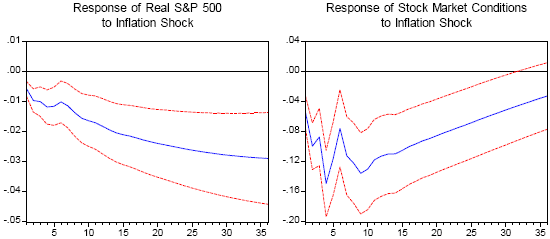How strong and persistent are the effects of inflation rate and interest rate shocks on the stock market? In the May 2008 draft of their paper entitled “Inflation, Monetary Policy and Stock Market Conditions”, Michael Bordo, Michael Dueker and David Wheelock quantify the extent to which various macroeconomic and policy shocks (industrial production, inflation, money supply growth, 10-year Treasury note yield and 3-month Treasury bill yield) explain the behavior of U.S. real stock prices and stock market conditions (trend) during the second half of the 20th century. Using monthly data for these variables and the S&P 500 index (as a proxy for stock prices) over the period August 1952 through December 2005, they conclude that:
- Inflation shocks relate negatively and persistently to both real stock prices and market trend, with the combined price and trend impacts explaining almost 33% of the stock market variation. For example, disinflation (inflation) shocks help explain the stock market boom of 1994-2000 (bust of 1973-74). See the charts below.
- Industrial production shocks relate positively but only temporarily to both real stock prices and market trend. These effects are not statistically significant.
- Money supply growth shocks do not significantly affect the stock market.
- Long-term interest rate shocks relate negatively and persistently to real stock prices. They relate negatively but only temporarily (three months) to market trend.
- Controlling for shocks to the long term interest rate, short-term interest rate shocks relate negatively (though not significantly) to real stock prices and positively to market trend over the short run. Over the long run, however, short-term interest rate shocks relate negatively to both real stock prices and market trend.
The following charts, taken from the paper, summarize the average behaviors (blue lines) of the real S&P 500 index and stock market conditions (trend) for 36 months after unexpected increases in the inflation rate. The red lines provide bounds of two standard deviations on either side of the averages. Positive inflation shocks tend to reduce real stock prices and degrade the market trend, thereby inducing further decline in real stock prices.

In summary, inflation shocks significantly affected the U.S. stock market over the past half century, with disinflation (inflation) shocks increasing (decreasing) stock prices and promoting boom (bust) conditions.